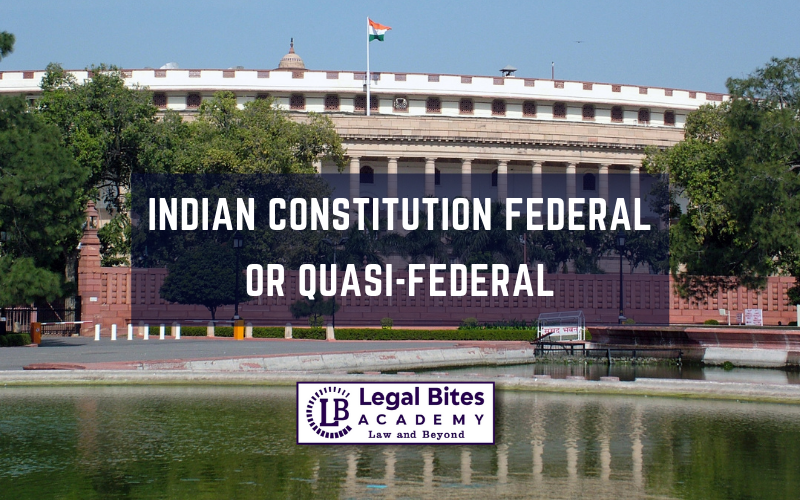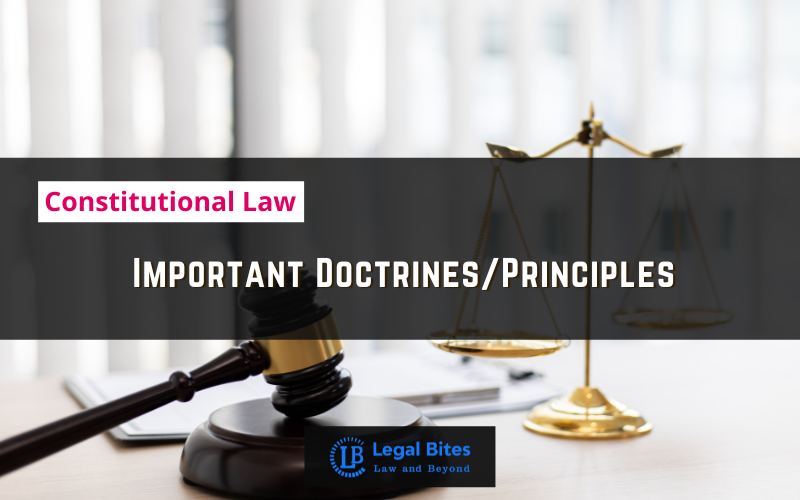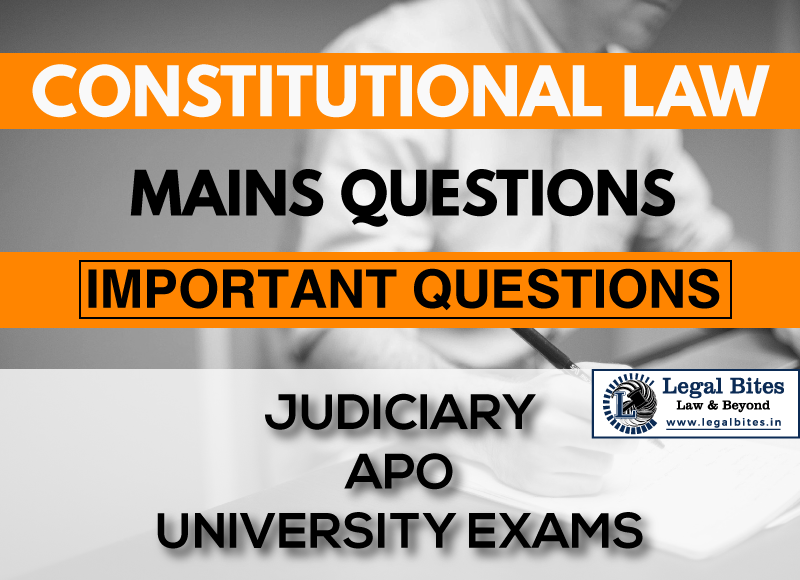Indian Constitution Federal or Quasi-Federal
This article on constitutional law discusses whether the Indian Constitution is Federal or Quasi-Federal. The Indian federalism was designed on the basis of the working of the federalism in the USA, Canada and Australia. Yet it deviates from that federalism in many respects and establishes its own distinctive features. There is a difference of opinion among scholars about… Read More »
;
This article on constitutional law discusses whether the Indian Constitution is Federal or Quasi-Federal. The Indian federalism was designed on the basis of the working of the federalism in the USA, Canada and Australia. Yet it deviates from that federalism in many respects and establishes its own distinctive features. There is a difference of opinion among scholars about the nature of the Indian constitution — whether it is federal or not. Federal characteristics of Indian...
This article on constitutional law discusses whether the Indian Constitution is Federal or Quasi-Federal.
The Indian federalism was designed on the basis of the working of the federalism in the USA, Canada and Australia. Yet it deviates from that federalism in many respects and establishes its own distinctive features. There is a difference of opinion among scholars about the nature of the Indian constitution — whether it is federal or not.
Federal characteristics of Indian constitution
There is a dual polity i.e. central and state government. There is a supreme constitution. Our constitution is a written and rigid constitution. It can be amended only to the extent of and in accordance with the provisions contained therein article 368. Further, the constitution establishes an apex court in the form of the Supreme Court to maintain the authority of the courts.
The constitution does incorporate the concept of federalism in various provisions. the provisions which establish the essence of federalism i.e. having states and a center, with a division of functions between them with the sanction of the constitution include, among others, lists 2 and 3 of the seventh schedule that gives plenary powers to the state legislatures; the authority to parliament to legislate in a field covered by the states under article 252, only with the consent of two or more states; the competence of parliament to legislate in matters pertaining to the state list, only for a limited period, under article 249, “in the national interest”, and, under article.
Article 258 (1) to entrust a state government (with the governor’s consent) functions in relation to which executive power of the union extends; decentralization of power through 73rd and 74th amendments; etc.
Deviations from federal characteristics: Unitary features of the Indian constitution
In the following matters, it is pointed out, the Indian constitution modifies the strict application of the federal principle:-
(1) Legislative relations – Under the art. 249, parliament is empowered to make laws with respect to every matter enumerated in the state list, if it is necessary for the national interest. In case of inconsistency between the laws made by parliament and laws made by the legislature of states, the laws made by parliament whether passed before or after the state law in matters enumerated in the concurrent list, to the extent of repugnancy prevail over the state law.
In case of overlapping between the matters of three lists i.e. union, state and concurrent list, predominance has been given to the union (article 246). The previous sanction of the president is required for the introduction of certain bills in the state legislatures (viz. art. 304).
(2) Administrative or Executive relations – All planning is at the union level (via planning commission), the states only implement the plans formulated by the union. The executive power of every state has to be exercised to ensure compliance with the laws made by parliament. article 365 authorizes the president to hold that a situation has arisen in which the government of a state cannot be carried on in accordance with the provisions of the constitution if the state fails to comply with or give effect to any directions given in exercise of the executive power of the union.
(3) Financial relations – the states depend largely upon financial assistance from the union (through grants-in-aid). power of taxation (which is exercisable by the states in comparatively minor fields, the more important such as income-tax, wealth-tax, excise-duties other than those on certain specified articles and customs, being reserved to the union) conferred by various entries under list ii on the states is also severely restricted.
(4) Parliament’s power to form new states and alter boundaries of existing states – The very existence of the state thus, under article. 3, depends upon the sweet will of the union.
(5) Appointment of governors – The governors of states is appointed by the president and answerable to him. They hold the office at the pleasure of the president. They thus act in a manner suitable to the president even at the cost of the interest of the states of which they are governors. There are provisions in the constitution under which the governor is required to send certain state laws for the assent of the president and the president is not bound to give his assent.
(6) Emergency provisions – under emergency, the normal distribution of powers between the center and states undergo a vital change (in the favour of the center). Under article. 356, the state legislature can be dissolved and the president’s rule can be imposed either on the governor’s report or otherwise when there is a failure of the constitutional machinery in a state.
(7) Single and uniform citizenship – for the whole country.
(8) Uniform and integrated judicial system – for the whole country.
(9) Inter-State council – if at any time it appears to the president that the public interests would be served by the establishment of a council charged with the duty of-
(a) inquiring into and advising upon disputes which may have arisen between states;
(b) investigating and discussing subjects in which some or all of the states, or the union and one or more of the states, have a common interest; or
(c) making recommendations upon any such subject and, in particular, recommendations for the better co-ordination of policy and action with respect to that subject, it shall be lawful for the president to establish such a council, and to define the nature of the duties to be performed by it and its organization and procedure (Article. 263).
(10) Freedom of trade and commerce — for the whole country. The comprehensive provisions of part 13 seek to make India a single economic unit for purposes of trade and commerce under the overall control of the union parliament and the union executive.
Thus, in certain circumstances, the constitution empowers the center to interfere in the state matters and thus places the states in a subordinate position or converts the union into a unitary state, which violates the federal principle.
Criticism of Wheare’s Views
The term “quasi-federal” as suggested by Wheare is very vague as it does not denote how powerful the center is, how much deviation there is from the pure ‘federal model’, etc. it may be that center has been assigned a larger role than the states but that by itself does not detract from the federal nature of the constitution, for it is not the essence of federalism to say that only so much, and not more power, is to be given to the center.
Federalism varies from place to place, and from time to time depending on factors like – historical, geographical, economic and political. Indian constitution is sufficiently federal, and it is no less federal than American federalism. The framers of the Indian constitution kept in view the practical needs of a country designed on a federal structure not on the footing that it should conform to some theoretical or standard pattern, but on the basis that it should be able to subserve the need of the vast and diverse country like India.
Conclusions: Indian federalism is ‘unique’
India adopted a federal structure as the different parts of the country were at different stages of development and it would have been difficult to control from one centre, and to ensure minorities their due place.
However, Indian federalism is unique because of its mode of formation i.e. from union to states (creation of autonomous units and then combining them into a federation), and not vice versa. It is to be noted that the term ‘union of states’ (article. 1) and not ‘federation’ is used in the constitution. Also, the units have no right to secede (as in a confederation).
The constitution of India is neither purely federal nor purely unitary but is a combination of both. It is a union of composite states of a novel type. Neither the parliament nor the state legislation is ‘sovereign’ because each being limited by the constitutional provisions affecting the distribution of powers. The constitution enshrines the principle that in spite of federalism, the national interest ought to be paramount. Thus, the Indian constitution is mainly federal with unique safeguards for enforcing national unity and growth.
The scope of application of the federal principle in India is shown by the scope of state legislatures. However, the Indian federation is not defective; the defect is political because there is a conflict between opposition-party ruled states and the central government. Also, federalism is not dead in India, as evidenced by the fact that new regions are demanding statehood and union has yielded, thus states like Manipur, Tripura, Goa, etc. have been created. Moreover, in spite of conflicts, the opposition-party ruled states do exist.




